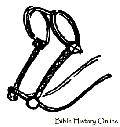
|
Danish Bridle Copied From The Door Of A Church
|
|
Danish bridle copied from the door of a church carved in the 10th or 11th century. Now in the Museum of Copenhagen. |

|
Danish Bridle Copied From An Aquamanile Of The 12th Century
|
|
Danish bridle copied from an aquamanile of the 12th century. Now in the Copenhagen Museum. |

|
Bridle From A Bas-Relief in the Church Of Brioude
|
|
Bridle from a bas-relief in the church of Brioude, carved in the 9th century. |

|
Norman Bridle Of The 11th Or 12th Century
|
|
Norman bridle of the 11th or 12th century, copied from the Bayeux Tapestry. |

|
Roman Solid Bit
|
|
Roman solid bit. In the Meyrick Collection. |

|
Jointed Bit
|
|
Jointed bit also called snaffle, without cross-piece, copied from MSS of 9th and 10th centuries. |

|
Norman Bit Without Joint
|
|
Norman bit without joint, from end of the 11th century. In the Bayeux Tapestry. |

|
Bridon, Snaffle Or Jointed Bit With Branches
|
|
Bridon, snaffle, or jointed bit wit branches. Belonging to the iron age or the commencement of the middle ages. In the Museum of Copenhagen. |

|
German Bit Without Joint Or Branches
|
|
German bit without joint or branches, from a set of harness in the Dresden Museum. |

|
16th Century German Bit
|
|
16th century German bit without joint and with long branches and cross-piece. In the Museum of Artillery in Paris. |

|
Branch Or Cross-Piece Of A Bit
|
|
Branch or cross-piece of a bit in perforated iron, of the 16th century. In the Museum of Artillery in Paris. |

|
Bit With Chains
|
|
Bit with chains belonging to an Arab bridle. In the Museum of Artillery in Paris. |












